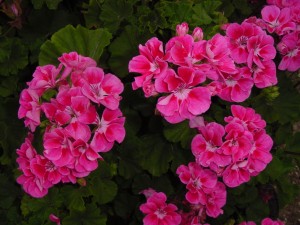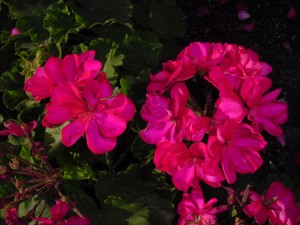February 10, 2007 Article
 Geraniums are usually classified as a ‘short-lived perennial,’ which means they typically live for more than a single year but these two varieties may merit a “perennial” classification in South Texas since they do well in summer and winter.
Geraniums are usually classified as a ‘short-lived perennial,’ which means they typically live for more than a single year but these two varieties may merit a “perennial” classification in South Texas since they do well in summer and winter.
You can use these geraniums in beds and borders. A wide range of colors is available to complement virtually any color scheme you desire. In southern California (and now maybe in South Texas!), geraniums are used as a colorful groundcover on slopes and lawns. They are excellent in containers of all types: from small pots, large tubs, window boxes, and they combine well with other plants, such as petunias and ivies. Geraniums are one of your best bets for use in hanging baskets.
 Common Geranium, Garden Geranium, Zonal Geranium
Common Geranium, Garden Geranium, Zonal Geranium
Scientific Name: Pelargonium hortorum as per L.H. Bailey
Family: Geraniaceae
Common Geranium, Garden Geranium, Zonal Geranium (Pelargonium hortorum)
(P. x domesticum, largely derived from P. cucullatum, P. angulosum, and P. grandiflorum) have large pansy like flowers, few to the cluster.
Zonal, house, or bedding geraniums (P. x hortorum, a complex hybrid largely derived from P. inguinans and P. zonale) are the familiar forms in garden culture and in pots indoors. These species were introduced in Europe in the early 18th century and hybridizers have been busy creating stunning new varieties ever since.
Frost Tolerance: Hardy in San Antonio.
Heat Tolerance: Better considered as a cool season annual in San Antonio UNLESS ‘Strawberry Sizzle’ and ‘Violet’ varieties are used.
Sun Exposure: Light shade in summer in San Antonio UNLESS ‘Strawberry Sizzle’ and ‘Violet’ varieties are used then they can be planted in full sun
Origin: South Africa
Growth Habits: Shrubby perennials generally grown as tender annuals, up to three feet tall (45 cm)
Plant in ordinary well-drained soil. Plants grown in containers like to be root bound. Over-fertilization may result in excessive foliage and few flowers. When fertilizing, use Osmocote Slow-Release Fertilizer pellets for containers and use a NON-weed-and-feed Slow-release fertilizer such as 19-5-9 for beds or a 4-2-3 organic analysis.
Moisture: Keep soil moist during hot weather. Allow to dry between waterings during cool periods. Constantly wetting the soil will quickly rot roots. Treat with Turficide, a fungicide that contains terrachlor, if rot occurs. Use Daconil Fungicide for foliage disease if spots appear on the leaves.
Hardiness: USDA Zones 8 – 10. The geranium hybrids are tender perennials. They are grown as annuals in cooler zones. Plants can be dug and potted and brought inside for the winter. Some gardeners prefer to dig the plants and remove all of the soil from the roots. The roots are wrapped in newspaper and the plants placed in a cool dry place until spring.
Propagation: Geraniums can be grown from cuttings. For more information about how to propagate geraniums from cuttings, visit this website for further information:
http://elkhorn.unl.edu/epublic/live/g190/build/#propagation.
To propagate geraniums from cuttings, first select containers three to four inches deep and fill them with moist (not overly wet) planting medium. Satisfactory rooting media include coarse sand, perlite, vermiculite or a mixture of these. Sterile commercial mixes are also available. Cut off shoot tips three to five inches in length and remove the leaves on the lower part of the stem. The use of a rooting hormone is recommended to stimulate the rooting process. This product is available at most garden centers. Dip the bottom one-half inch of each cutting in the rooting medium. Insert the cuttings to a depth of one and one-fourth inches to one and one-half inches. Firm the medium around the cuttings.
Avoid crowding the cuttings so there will be some air movement to help prevent disease. Cover the container with a plastic bag. This helps prevent excessive moisture loss, decreases wilting and increases rooting potential. Place the container in a warm location that receives bright, but indirect sun. Avoid excessive heat buildup in the bag by occasionally opening the top.
Check the moistness of the rooting medium every week. If properly chosen and prepared, it will usually stay fairly moist for several weeks before additional water is needed.
To determine when the cuttings have rooted, gently tug on the stem. If it resists being pulled from the rooting medium, roots have probably developed to a length of one-half inch to one inch, and the cuttings can be planted in small individual containers. Fill these containers with a coarse, well-drained growing mix, and pot the cuttings at the same depth as the original rooting medium. Gradually move the plants into more direct light and continue to water. Fertilization will not be needed until the cuttings show new top growth.
For more information visit this link at:
http://www.ag.ndsu.edu/pubs/plantsci/landscap/h1257w.htm#asexual
David Rodriguez is the County Extension Agent-Horticulture for Bexar County. For more information, call the Master Gardener ‘Hotline’ at (210) 467-6575 or visit our County Extension website at: http://bexar-tx.tamu.edu and click on Horticulture and Gardening.